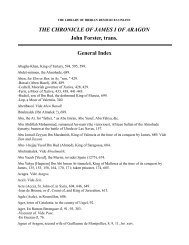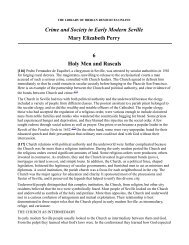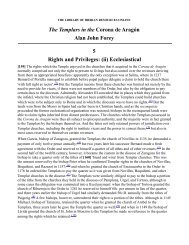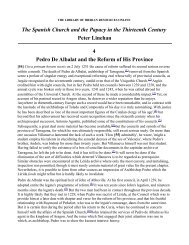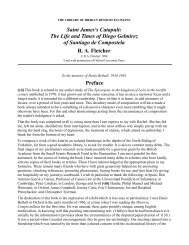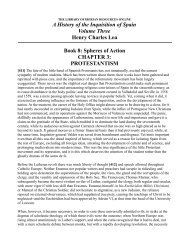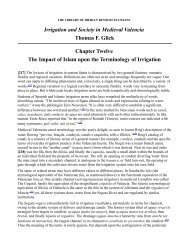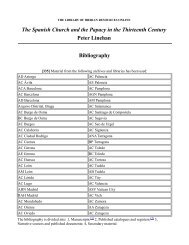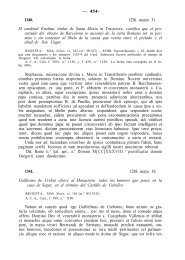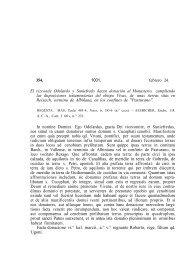The Pactual Tradition in Hispanic Monasticism - The Library of ...
The Pactual Tradition in Hispanic Monasticism - The Library of ...
The Pactual Tradition in Hispanic Monasticism - The Library of ...
Create successful ePaper yourself
Turn your PDF publications into a flip-book with our unique Google optimized e-Paper software.
egularum for the sole observance <strong>of</strong> the Montecass<strong>in</strong>ese code; and whatever the precise roles we<br />
ultimately assign <strong>in</strong> this transformation to the Carol<strong>in</strong>gian reformism <strong>of</strong> Benedict <strong>of</strong> Aniane, the latter's<br />
enthusiastic Catalan partisans, the <strong>in</strong>fluence <strong>of</strong> the Cluniacs under Sancho el Mayor, Fernando el<br />
Magno and Alfonso VI, and the Franco-<strong>Hispanic</strong> or afrancesado bishops <strong>of</strong> the 11th century, it now has<br />
to be recognized that west <strong>of</strong> the <strong>Hispanic</strong> Mark the Benedict<strong>in</strong>e victory was a slow, stubbornly resisted<br />
process which pr<strong>of</strong>oundly affected, along very diverse chronological and regional l<strong>in</strong>es, the religious<br />
and cultural history <strong>of</strong> the Alta Reconquista.<br />
<strong>The</strong> other aspect <strong>of</strong> the subject, no less complex and even more controversial, bears upon the question<br />
whether the <strong>in</strong>digenous cenobitism was not itself deeply divided for centuries, both before and after<br />
711, between two contrast<strong>in</strong>g and <strong>in</strong> part hostile traditions, one <strong>of</strong> orthodox type, similar <strong>in</strong> spirituality<br />
and <strong>in</strong>stitutional organization to that characteristic <strong>of</strong> the pre-Benedict<strong>in</strong>e West, the other a<br />
constitutionally quite different movement, orig<strong>in</strong>ally Galaico-Portuguese <strong>in</strong> provenance, which came to<br />
be deeply rooted <strong>in</strong> central and western Iberia dur<strong>in</strong>g the first centuries <strong>of</strong> the Reconquista and which<br />
can be described, for comparative purposes and without theological implications, as heterodox. This<br />
second pen<strong>in</strong>sular ascetic tradition, along with the thesis <strong>of</strong> the remarkable duality <strong>of</strong> <strong>Hispanic</strong><br />
cenobitism prior to the ultimate establishment <strong>of</strong> Benedict<strong>in</strong>ism, is the subject <strong>of</strong> the slim but<br />
authentically path-break<strong>in</strong>g volume published <strong>in</strong> 1907 at Stuttgart by Dom Ildefons Herwegen <strong>of</strong> Maria<br />
Laach Abbey, then still a young student but already display<strong>in</strong>g the talents and scholarship he was later<br />
to devote as abbot to historical science and the modern liturgical movement. <strong>The</strong> work, entitled Das<br />
Pactum des hl. Fruktuosus van Braga: e<strong>in</strong> Beitrag zur Geschichte dês suevischwestgotischen<br />
Mönchtums und se<strong>in</strong>es Rechtes, was repr<strong>in</strong>ted <strong>in</strong> 1965 and rema<strong>in</strong>s one <strong>of</strong> the truly fundamental<br />
contributions to the study <strong>of</strong> early medieval Luso-<strong>Hispanic</strong> monastic history, (4) although <strong>in</strong> recent [3]<br />
years its contentions have been <strong>in</strong>creas<strong>in</strong>gly challenged and have become the subject <strong>of</strong> lively debate.<br />
What the German Benedict<strong>in</strong>e modestly styled a Beitrag has <strong>in</strong> fact resulted <strong>in</strong> a renewed scrut<strong>in</strong>y <strong>of</strong>.<br />
long known monastic writ<strong>in</strong>gs and other documentation <strong>of</strong> the Visigothic and post-Visigothic eras, a<br />
search for new or previously neglected texts, and, above all, a major effort to resolve the complex<br />
problematics <strong>of</strong> the genesis, l<strong>in</strong>es <strong>of</strong> diffusion and comparative significance <strong>of</strong> the two rival pre-<br />
Benedict<strong>in</strong>e <strong>Hispanic</strong> traditions, the orthodox Visigothic and the Luso-Gallegan heterodox. S<strong>in</strong>ce some<br />
lead<strong>in</strong>g authorities deny the very existence <strong>of</strong> this duality before or after 711, this has given rise to<br />
sharply conflict<strong>in</strong>g <strong>in</strong>terpretations and drawn <strong>in</strong>to the discussion such Spanish and Portuguese<br />
specialists as Pérez de Urbel, Mário Mart<strong>in</strong>s, Anscari Mundo, Manuel Díaz y Díaz, José Orlandis,<br />
Ramón Abadal i de V<strong>in</strong>yals, Antonio L<strong>in</strong>age Conde, José Mattoso, and others, and from outside Iberian<br />
soil Maur Cocheril, Claude Barlow, and the present writer.<br />
<strong>The</strong> controversy has done much to enrich and deepen our whole understand<strong>in</strong>g <strong>of</strong> early <strong>Hispanic</strong><br />
monachism, but it is fair to say that on the central issues no notable degree <strong>of</strong> consensus has yet been<br />
reached. <strong>The</strong> follow<strong>in</strong>g pages propose to consider, therefore, although <strong>in</strong>evitably much more summarily<br />
than the many complexities <strong>of</strong> the theme make desirable, the chief po<strong>in</strong>ts <strong>in</strong> dispute; to defend the<br />
validity <strong>of</strong> certa<strong>in</strong> <strong>of</strong> Herwegen's more fundamental contentions; and to call attention to some hitherto<br />
ignored or misunderstood aspects <strong>of</strong> the Luso-Gallegan tradition that are central to its correct<br />
understand<strong>in</strong>g both before and after the year 711. Such a survey, if it does not br<strong>in</strong>g the warr<strong>in</strong>g camps<br />
closer together, may at least encourage renewed <strong>in</strong>vestigation <strong>in</strong>to the authentic role <strong>of</strong> the pactual<br />
tradition <strong>in</strong> the monastic history <strong>of</strong> the <strong>Hispanic</strong> Middle Ages.




